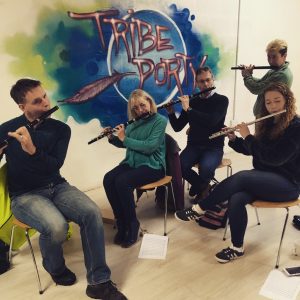Calum Sgàire (Òran Chaluim Sgàire) is a Gaelic love song from Bernera that was the focus of the February workshop in Edinburgh. We also looked at a Swedish tune (Engelska frå Småland) and had fun with Laridé de Portobello.
The story behind the song can be found here. Here’s the rich Bothy Band arrangement of the song, which is the one I am most familiar with, having first heard it in 1982:
Other versions can be readily found too. However, the instrumental version that we focused upon was that by fiddler Alisdair Fraser with Tony McManus on guitar:
Convention holds that the best way to learn a song air is directly from a sung version. This provides an understanding of the lyrics and phrasing that underpins the delivery of a fine narrative. This is important when playing flute or whistle as the breathing and dynamics are able to closely match that of the singer. (The best performances of song airs on flute or whistle are often singers).
The next best way is to learn from a musician who knows the song, but also to have an existing understanding or performance of the song in mind. This provides an anchor to reference. In Alisdair Fraser’s playing, the bow performs the role of the breath and it swells, rises, falls, stops, pulls and pushes the timing to bring out a sense of the story.
Additionally, certain grace notes and articulations lend themselves to the fiddle, much as they do with other instruments, including the voice. We sang along with the song to get a strong sense of the phrasing and inflections and then also to the fiddle version, which was simpler to focus upon due to the simple and sparse arrangement.
I have put a bare bones written version of this in the resources section. The arrangement does attempt to show how to negotiate the phrases that go below the flute range and it should help when referring back to the original.
The question of fingered vibrato (ghost trill, or flattement in Baroque flute parlance) arose and we tried a few ideas out for this. Each flute and whistle will be different and various combinations of fingers will suit different situations. It is worth taking the time to try these out and they aren’t confined to slow airs, but may also appear where notes are held in other tunes too.
The Engelska (a Swedish interpretation of an English dance) I learned from Fun Fiddle in Portobello. We tried out some harmonies and Malcolm Reavell contributed a third one on the spot for his sonorous A flute. Here’s an authentic Swedish version, that shows we were in the ballpark. Note the bowing emphasis, which squeezes and stretches the melody:
The next workshop takes place on Saturday 23 March and will focus on a set of Irish jigs. A recording for this will be sent out in advance.
Look out for the Annual flute and whistle weekend on 26-28 April. Lots of things happening that weekend: workshops, performances and sessions featuring flutes and whistles.




 This week we covered the Laridé de Portobello, a nine-part piece for flutes, whistles and other folk instruments based on a traditional Breton two-part tune that had no name. This is a tune I have taught previously and the intention of the multiple parts is to encourage group play, improvisation and performance. With the end of a term of hard work coming up, it’s good to focus on such things.
This week we covered the Laridé de Portobello, a nine-part piece for flutes, whistles and other folk instruments based on a traditional Breton two-part tune that had no name. This is a tune I have taught previously and the intention of the multiple parts is to encourage group play, improvisation and performance. With the end of a term of hard work coming up, it’s good to focus on such things.